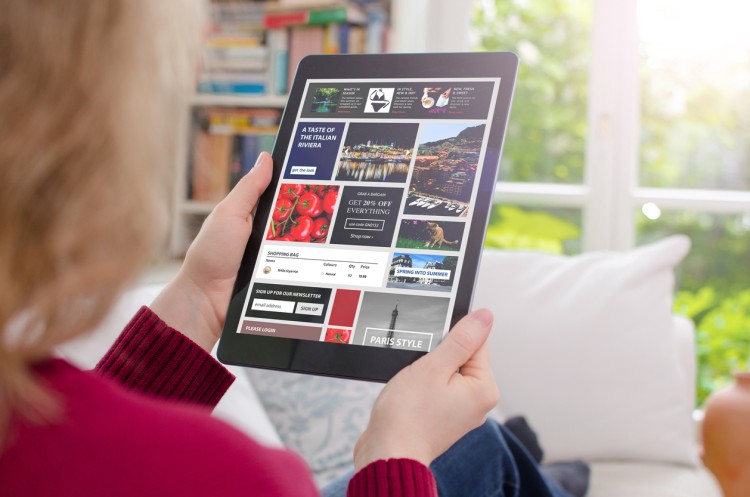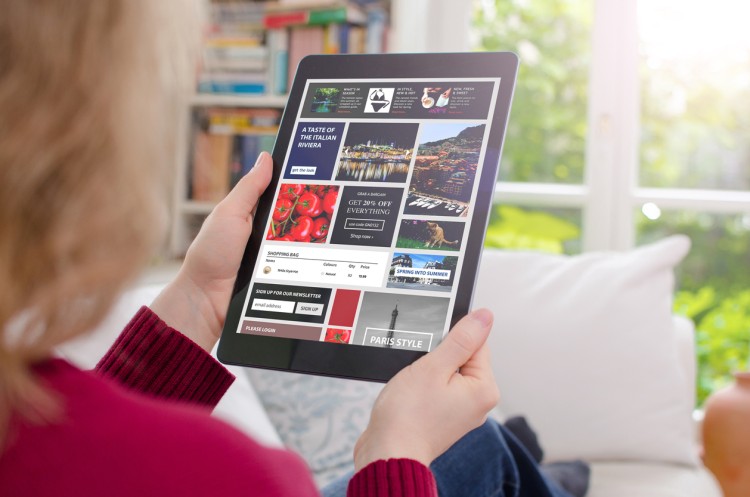What Is Programmatic Advertising?

Advertising has gone digital — and the lion’s share of it is programmatic, or digital in nature.
Digital spending was projected to rise from 58% to nearly 64% of global media advertising between 2020 and 2022, according to eMarketer’s Worldwide Digital Ad Spending 2021 report. Setupad shared findings from a 2021 Statista report that showed the dominance of programmatic advertising: The report predicted that 82% of global digital advertising would be programmatic by 2022.
But what is programmatic advertising, and how does it help marketing professionals promote their products and services in this digital advertising age?
Programmatic advertising refers to the use of technology to buy and sell digital ads. It capitalizes on advances in machine learning and artificial intelligence (AI) to help advertising and marketing professionals maximize the effectiveness of their ad placements.
Today’s marketers need to understand this system for purchasing digital ads. A bachelor’s degree in marketing program that focuses on digital approaches can provide a solid foundation in using this increasingly important method of promoting products and services.
How Does Programmatic Advertising Work?
Programmatic advertising is a form of digital advertising, or paid advertising that appears on online platforms. Digital advertising can be found on websites and apps that range from YouTube to the online version of The New York Times.

Today, when advertisers purchase digital ads, they have largely moved away from the traditional method of negotiating and bidding for ad space. Instead, they’re more likely to use a quicker, automated approach: programmatic advertising.
In programmatic advertising, individuals and organizations use AI-generated data to condense the steps of purchasing ad space and placing ads.
In many cases, they use an online marketplace called an ad exchange to bid on advertising inventory that meets their advertising goals, with their participation in that online marketplace driving the price of ads available for purchase. Algorithms and analytics calculate competing bids for ad space and then instantly post the ad for the winning bidder.
To ensure proper ad placement, advertising and marketing professionals determine their advertising goals and study the marketplace to determine which forms of online advertising — display ads or video, for example — best align with those goals.
After determining their target audience for the ads, they choose specific parameters such as keywords, location, and demographics that define that audience, and use those parameters to drive ad placement. So, an ad for a car company that’s trying to reach a certain audience will appear on a website, streaming service, or app whose users match the designated parameters for that audience. Programmatic advertising through an ad exchange follows these steps:
- A consumer uses a form of digital media — clicking on a website, for example — creating what’s called an impression.
- The digital media publisher — the seller of the ad space — puts that impression up for auction through software that facilitates digital ad sales.
- An advertiser uses software for digital ad purchasing to determine which impressions to buy and what price makes sense according to factors such as demographics, consumer browsing behavior, ad strategy, and budget.
- The publisher automatically assigns impressions to the winning bidder for that advertising space, according to the highest price per 1,000 impressions.
- The ad from the winning bidder instantly appears on the website.
Ad buyers monitor the programmatic advertising process to evaluate whether their ads are reaching the right audiences. To gauge an ad’s effectiveness, they evaluate outcomes such as impressions, clicks, sales, subscriptions, and user engagement.
What Are the Types of Programmatic Advertising?
Programmatic advertising is what many advertising and marketing professionals use to help ensure efficient and effective ad placement, but ad buyers must also select a type of programmatic advertising. These four options affect how ads are placed:
Real-Time Bidding
Real-time bidding (RTB) is the most popular type of programmatic advertising because of its simplicity and the amount of price control and transparency it provides advertisers. With RTB, sometimes called programmatic media buying, bidders purchase ad space at an open auction, with the highest bid winning the ad placement.
But RTB doesn’t necessarily require advertisers to pay their bid amount. Instead, they pay just 1 cent more than the second-highest bidder. The public nature of this process makes it easier for advertisers to get advertising slots they can afford in the channels where they want to publish, although there is a chance the purchased ad could run on the wrong site.
Preferred Deals
Under the preferred-deal method of programmatic advertising, advertisers choose a place for their ad before an auction for that placement opens. Negotiations related to the ad purchase take place before the real-time auction begins, resulting in preferred deals for buyers — who can accept or reject those deals. If an advertiser rejects a deal, it goes to the private marketplace. Then, if there still is no deal for the placement, it goes to an open auction.
This type of programmatic advertising offers the opportunity for good deals to select buyers, who can review placement options in advance. Additionally, those deals might carry over to the next opportunity for ad purchase. However, preferred deals do require more effort from the advertiser than RTB, and buyers run the risk that a placement is unavailable because of a prior deal with another party.
Private Marketplace
Another private bidding option for programmatic advertising is conducted through the private marketplace (PMP) and is open on an invitation-only basis. With PMP, online publishers prepare premium ad placement opportunities for certain advertisers, instead of conducting a public auction for any advertiser interested in bidding. If no advertiser purchases the placement, it goes to RTB.
With a PMP, the advertiser knows the exact placement of the ad and, as with preferred deals, gets early access to inventory. Also like preferred deals, however, a PMP requires more work from the advertiser. And there’s no guarantee of winning the auction.
Programmatic Guaranteed
The programmatic-guaranteed approach is the type of programmatic advertising that’s closest to traditional media buying. Also known as automated guaranteed or programmatic direct, this process doesn’t involve bidding; it relies on negotiations between advertisers and online publishers to determine pricing and ad placements.
Using the programmatic guaranteed process for programmatic advertising ensures placement and impressions on specific sites. It also puts the advertiser in control of choosing the ad space as well as the ad frequency and price. Programmatic guaranteed offers fewer options for including a variety of ad channels than other types, however, as well as less flexibility in adjusting finalized ad purchases according to performance.
What Are the Benefits and Drawbacks of Programmatic Advertising?
After learning what programmatic advertising is, advertising and marketing professionals can evaluate its pros and cons to determine whether it’s right for promoting their products and services. Efficiency, reach, and accountability are factors in programmatic advertising’s growth in popularity — but this approach to digital marketing does have potential drawbacks.
Advantages of Programmatic Advertising
Programmatic advertising can offer businesses efficiency and reach that more traditional forms of ad buys typically don’t provide. Among the potential benefits of programmatic advertising are the following:
- Targeted. AI data allows ads to target just the specific audiences the advertiser wants to reach.
- Efficient. A streamlined process eliminates steps related to purchasing and placing ads.
- Algorithms in programmatic advertising can catch the characteristics of bots and other improper ad placements and remove them from buys.
- Programmatic advertising often allows access to review space available for ad buys as well as real-time measurement of the results those purchases yield.
- Far-Reaching. Ads can appear across a wide variety of digital platforms.
Disadvantages of Programmatic Advertising
Programmatic advertising can present challenges as well, with concerns ranging from its complexity to its saturation of the digital advertising landscape. Following are among the potential disadvantages of programmatic advertising:
- The many facets of programmatic advertising can make its use challenging for those new to the process.
- Expense. Programmatic advertising can be expensive, although its potential to reach a more specific audience can offset the additional cost.
- Information about the placement of ads is not always available.
- Banner ads — which appear on the top, bottom, or side of an online page — compose a large portion of programmatic advertising; this type of ad can have low click-through rates.
- With so many digital advertisers using programmatic advertising, competition for ad space can be fierce.
Take a Brave Step Toward the Future of Advertising
With digital advertising — especially programmatic advertising — playing such a large role in today’s advertising and marketing world, individuals interested in pursuing a career in marketing should pursue an education that focuses on digital processes. The Maryville University online Bachelor of Science in Marketing program teaches traditional and emerging concepts in the field, while also providing the convenience and flexibility of online learning. Discover how Maryville’s online bachelor’s in marketing can help you lead the next wave of advertising.
Recommended Reading
6 Media Planning Strategies to Grow Your Marketing Efforts
6 P’s of Marketing to Grow Your Business
Sources
Amazon Ads, “A Beginner’s Guide to Programmatic Advertising”
DigitalMarketer, “Everything You Ever Needed to Know About Digital Advertising”
EMarketer, “Worldwide Digital Ad Spending 2021”
IBM, “What Is Programmatic Advertising?”
Industrial Marketer, “The Magic and Mystery of Programmatic Advertising”
Investopedia, Banner Advertising Marketing91, “What Is Programmatic Advertising: Importance and Types”
The Online Advertising Guide, Definition: Ad Impression
SendPulse, “What Is Programmatic Advertising: Basics”
Setupad, “22 Key Digital Advertising Trends and Stats for 2022”
Statista, “Digital Advertising Report 2021”
WebFX, “What Is Real-Time Bidding? Real-Time Bidding in Under 5 Minutes”

